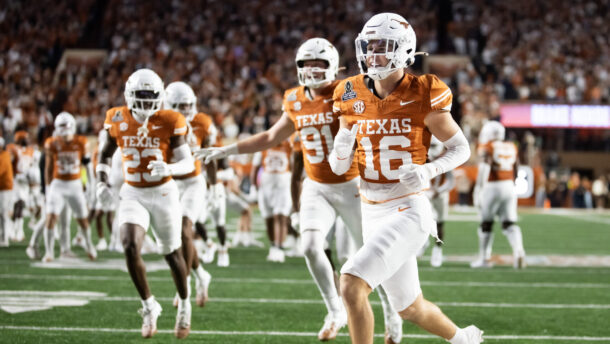
#ItMightMeanTooMuch: Why Georgia’s staggering recruiting bill is at the root of my change of heart
I used to be that guy.
Any time I’d listen to someone rant about how college football players deserved to be paid, I’d say the same thing.
“They are paid. A university invests hundreds of thousands of dollars into each one of them. They don’t have tens of thousands of dollars worth of student loan debt like I do.”
For what it’s worth, I still believe there’s great value in a scholarship. Anybody who scoffs at what a 4-year degree from a Division I university can do is foolish. That’s not to say that college is for everyone, but it can absolutely benefit anyone. That, I believe.
But tweets like the one I saw the other day about Georgia’s recruiting spending have actually changed my thinking to the all-important “should college athletes be paid” question:
Georgia’s recent annual football recruiting spending (not inflation adjusted):
FY14: $717,092
FY15: $1,340,244
FY16: $2,195,966
FY17: $2,270,960
FY18: $2,626,622
FY19: $3,676,858https://t.co/kzfDSx0vFC— Steve Berkowitz (@ByBerkowitz) February 3, 2020
That’s an increase of spending of 500% in a 5-year stretch. Not coincidentally, that’s the exact stretch in which the SEC Network has been in existence. Cable TV has changed the sport forever, and to think that the circumstances are the same now as they were in 2010 — when I formed that opinion — is factually wrong.
So why should I or anyone else pretend that a significant shift didn’t happen in the latter half of the decade?
Now to be clear, Georgia is a bit of an outlier as it relates to that spending. According to that story from the Athens Banner-Herald, the Dawgs were actually No. 1 in America in recruiting spending in 2018, and then they beefed up the budget another $1.05 million in 2019, which was easily the program’s biggest jump during that 5-year stretch. From 2016-18, No. 2 Alabama spent $5.56 million on recruiting while No. 3 Tennessee spent $5 million (Courier Journal).
Fans of those respective teams will simply say, “that’s the cost of greatness.” Quite frankly, Alabama and Georgia fans would have a point. With Kirby Smart inking the No. 1 class in the 2020 recruiting cycle, that meant that each of the past 10 years, the nation’s top-rated class came from either Georgia or Alabama.
The Banner-Herald article also outlined that Georgia operated at a $30.7 million surplus during the last fiscal year (which ended in June), yet that wasn’t even the top in the SEC thanks to Texas A&M’s $43.7 million surplus. That’s how you justify giving a $75 million guaranteed contract to a coach.
Want more numbers? I’ve got more numbers.
Last week, the SEC’s annual revenue distribution numbers came in. They were, as one would guess, off the charts:
A Decade of Dollars 📈📊💸 pic.twitter.com/uV6n10ei6n
— Paul Finebaum (@finebaum) January 31, 2020
That’s right. When I had my original take, it was when the almighty SEC pulled in $220 million. That’s roughly 1/3 of what that number is at now.
I know what you might be thinking. “Like Georgia is with its recruiting spending, the SEC is the outlier when it comes to this.” Believe it or not, it actually isn’t. The Big Ten’s annual revenue distribution figure was $759 million … last year (it won’t release its 2018-19 numbers until the spring). Part of that is because it offers more varsity sports than the SEC, and an even bigger part of that was because the conference was at the forefront of the booming TV rights market.
And it’s not just the Georgias and Alabamas of the world that dropped serious coin on recruiting. In 2018, 15 programs spent north of $1 million on recruiting that year (via Stadium). Actually, that was only for the programs that released that information. Alabama, Auburn, Tennessee, Miami, Notre Dame and USC didn’t release those figures, but it’d be surprising if they weren’t also well north of $1 million.
Shoot, we’ve even got basketball programs now spending north of $1 million on recruiting (cheers, Kentucky). That’s for a sport with a fraction of the scholarship players that football has.
What does all of this show? It’s simple. You spend a lot of money to make a lot of money.
How can one see those astronomical figures and pretend it’s still the same system it was 10 years ago? It’s not. And this isn’t just about allowing athletes to make money off their likenesses, which appears to be facing a breakthrough in the 2020s.
If there’s this much money coming in and this much money being spent on things like recruiting, surely we can figure out a stipend scenario that makes some sort of sense. Anarchy isn’t the answer, but neither is naivety. Not to go all Jay Bilas here, but the “there’s just not the money to do it” is a dated, lazy excuse. It’s especially lazy when it comes from coaches who have watched their salaries skyrocket with the TV rights boom in the 2010s.
I used to believe that the problem it would create to kick some money back to the athletes — and why I think athletic directors want to continue to avoid this — is that they don’t want to justify who gets what. Like, why should an LSU soccer player get the same stipend as Joe Burrow? By paying Burrow a richer stipend, you’re essentially telling your university that one sport is more important than the other.
Uh, call me crazy, but don’t we already see that with the scholarship distribution? One sport gets 85 of them while some non-revenue sports end up having players on partial scholarships.
And here’s the other thing. If I’m a tennis player at Tennessee, I love seeing my football program selling out games and playing on national TV. Other sports are often dependent on the football program’s success to fund facility upgrades. That’s not some new dynamic.
What is new is how much these numbers increased. It seems like it’s only a matter of time before we’ve got schools like Georgia that are spending $5 million annually on recruiting. Why? It’s still a justifiable expense for the university to sign off on with how big those annual revenue distribution checks are. And at this rate, it’s only a matter of time before the Big Ten or the SEC becomes the first conference to distribute a billion-dollar check to its 14 schools.
Things have changed. Once upon a time, we also feared the forward pass. Look how that turned out.
It’s time that the NCAA recognize the need for a step forward with its business model. No matter what they say, it is indeed a business.
But I’m not about to hold my breath for the NCAA to get with the times and recognize what’s right.
I don’t suggest you do so, either.
Connor O'Gara is the senior national columnist for Saturday Down South. He's a member of the Football Writers Association of America. After spending his entire life living in B1G country, he moved to the South in 2015.







